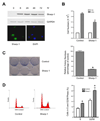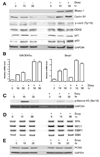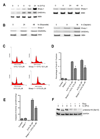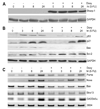Sharp-1 modulates the cellular response to DNA damage
- PMID: 20006609
- PMCID: PMC2812643
- DOI: 10.1016/j.febslet.2009.12.011
Sharp-1 modulates the cellular response to DNA damage
Abstract
DNA damage checkpoints are essential for maintenance of genome integrity. We report here that inducible overexpression of the transcription factor Sharp-1 results in an S and G2/M cell cycle arrest, concomitant with the upregulation of Brca1 and GADD45alpha expression. In addition, we show that endogenous Sharp-1 mRNA is increased by DNA-damaging agents. Consistently, Sharp-1 overexpressing cells exhibit reduced apoptosis in response to chemotherapeutic drugs along with lower p53 expression and activity. Our studies identify a novel function for Sharp-1 in cell cycle arrest and DNA damage-induced apoptosis. Inappropriate Sharp-1 expression may therefore be associated with tumorigenesis.
2009 Federation of European Biochemical Societies. Published by Elsevier B.V. All rights reserved.
Figures




References
-
- Bartek J, Lukas J. DNA damage checkpoints: from initiation to recovery or adaptation. Curr Opin Cell Biol. 2007;19:238–245. - PubMed
-
- Motoyama N, Naka K. DNA damage tumor suppressor genes and genomic instability. Curr Opin Genet Dev. 2004;14:11–16. - PubMed
-
- Zhou BB, Elledge SJ. The DNA damage response: putting checkpoints in perspective. Nature. 2000;408:433–439. - PubMed
-
- Meek DW. Tumor suppression by p53: a role for the DNA damage response? Nat Rev Cancer. 2009;9:714–723. - PubMed
-
- Taylor WR, Stark GR. Regulation of the G2/M transition by p53. Oncogene. 2001;20:1803–1815. - PubMed
Publication types
MeSH terms
Substances
Grants and funding
LinkOut - more resources
Full Text Sources
Research Materials
Miscellaneous

